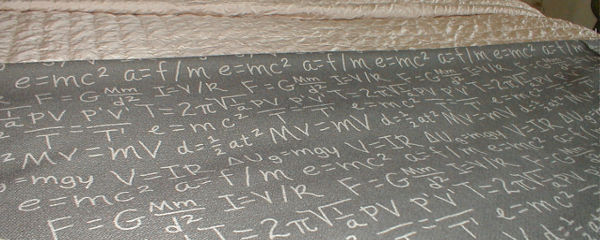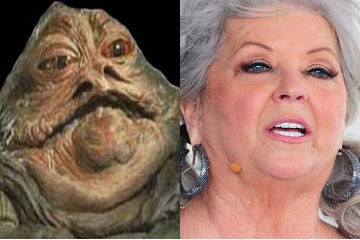What I’ve Learned:
“Hydrogen bonding: If you can’t keep it in your pants, keep it in your electron cloud.”
Hydrogen bonding is one of the most important chemical forces holding molecules and matter and us together. Without the power of hydrogen bonding, we’d all blob out into big piles of disorganized goo like Jabba the Hutt. Or Paula Deen.
(Hey, they’ve never been seen in the same room at the same time. I’m just saying.)
As attractive forces go, hydrogen bonding isn’t especially strong. A molecule could probably pull more electrons with Axe body spray and a couple of subatomic guitar lessons. If covalent bonding — solid, strong, crazy hard to break — is like a marriage, then hydrogen bonding is the “I’ll call you” after hooking up in the alley outside a downtown bar. Not exactly a sign of a committed molecular relationship.
Of course, there are advantages to keeping your options open. I’m not saying it’s a playah, chemical-interactionally-speaking, but hydrogen bonding gets around. Almost every substance critical to life on Earth — proteins, DNA, cronuts, you name it — contains hydrogen atoms. And those things are constantly getting busy rubbing up against each other, switching partners and saying to their hydrogen friends, “well, I ‘bonded’ him, but I didn’t ‘bond him, bond him’, you know?”
It’s like Penthouse Letters meets Mr. Wizard. But slightly less disturbing.
The craziest hydrogen bonding of all is in water.
(Because everything is sexier when its wet. Except possibly Mr. Wizard. Try not to think about that too much.)
A water molecule is chemically simple — one oxygen and two hydrogens, bound together in holy covalent matrimony. But like any threesome, even the sparkly vampire ones, nobody in the relationship is really happy. So the atoms all doll up at night and go hydrogen bonding — oxygens prowling for other hydrogens, and hydrogens making the move on every oxygen with a dipole and a pulse. These things make Don Juan look like… well, like Mr. Wizard.
Or Jabba the Hutt. Or Paula Deen. Only wetter.
What’s more, these electrostatic horndogs are good at hooking up, one-night-bonding with up to four other water molecules at a time. That’s good for us, because it’s all this hydro-boinking on the side that gives water its high melting point, high boiling point and makes ice float instead of sink. All of which are pretty important for us to continue to live and maintain mostly-unblobby shapes and eat trendy breakfast-pastry hybrids.
So be glad that hydrogen bonding works the way it does. Life wouldn’t be the same — or probably, wouldn’t be life at all — without it. Just try to forget that there’s basically an atomic-level key party orgy going on in the glass of water you’re drinking.
And don’t even ask what’s going on in that cup of coffee. Trust me, you do not want to know.



